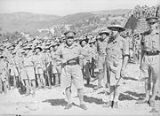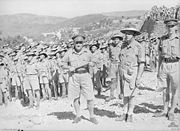
Battle of Damour
Encyclopedia
The Battle of Damour was the final major operation of the Australian forces during the Syria-Lebanon Campaign
of World War II
.
was the French administrative capital. Damour is a large town on the coast of Lebanon and is approximately 30 kilometres south of Beirut
.
The Wadi Damour, with the Damour River in its bed, was a further three kilometres to the south of the town. These features were the last major natural obstacles that had to be crossed prior to reaching Beirut. Having already captured the heights overlooking Damour on the south bank of the wadi, the plan developed by Major General Arthur "Tubby" Allen
, commanding the 7th Australian Division, involved encircling the Vichy French positions at Damour.
 On the night of 5 July 1941, the operation began with troops of the 21st Brigade
On the night of 5 July 1941, the operation began with troops of the 21st Brigade
moving into position to cross the Damour River in two places.
Early on 6 July, the Australians attacked Vichy French positions on the northern side. The 2/16th Battalion attacked at El Atiqa. The 2/27th Battalion attacked at El Boum. By nightfall, both positions were in Australian hands.
In the early hours of 7 July, the 2/3rd Battalion and the 2/5th Battalion, along with two companies of the 2/14th Battalion
, moved northwards through El Boum. They outflanked Damour to the east. At Daraya
, the 2/14th companies swung west to advance on Damour from the east, while the 2/3rd Battalion and the 2/5th Battalion continued north to cut the road to Beirut north of the town.
On 8 July, the Australians accomplished cutting the road. In the south, the 2/2nd Pioneer Battalion and elements of the 6th Divisional Cavalry Regiment were advancing along the axis of the coastal road.
By 2 am on 9 July, the Pioneers were advancing into the southern outskirts of the town. At 4 am a patrol from the cavalry were able to drive right through Damour. The remaining Vichy French forces had managed to slip out of the Australian encirclement and had withdrawn from Damour. The Australians immediately began pushing along the coastal road towards Beirut.
On 8 July, even before the fall of Damour, the Vichy French commander, General Henri Dentz
, had sought an armistice. At one minute past midnight on 12 July a ceasefire came into effect. For all intents and purposes, this ended the campaign.
Syria-Lebanon campaign
The Syria–Lebanon campaign, also known as Operation Exporter, was the Allied invasion of Vichy French-controlled Syria and Lebanon, in June–July 1941, during World War II. Time Magazine referred to the fighting as a "mixed show" while it was taking place and the campaign remains little known, even...
of World War II
World War II
World War II, or the Second World War , was a global conflict lasting from 1939 to 1945, involving most of the world's nations—including all of the great powers—eventually forming two opposing military alliances: the Allies and the Axis...
.
Background
In 1941, DamourDamour
Damour is a Lebanese Christian town that is 24 kilometres south of Beirut. The name of the town is derived from the name of the Phoenician god Damoros who symbolized immortality ....
was the French administrative capital. Damour is a large town on the coast of Lebanon and is approximately 30 kilometres south of Beirut
Beirut
Beirut is the capital and largest city of Lebanon, with a population ranging from 1 million to more than 2 million . Located on a peninsula at the midpoint of Lebanon's Mediterranean coastline, it serves as the country's largest and main seaport, and also forms the Beirut Metropolitan...
.
The Wadi Damour, with the Damour River in its bed, was a further three kilometres to the south of the town. These features were the last major natural obstacles that had to be crossed prior to reaching Beirut. Having already captured the heights overlooking Damour on the south bank of the wadi, the plan developed by Major General Arthur "Tubby" Allen
Arthur Samuel Allen
Major General Arthur Samuel "Tubby" Allen CB CBE DSO VD was an Australian soldier. During World War II he reached the rank of Major General and commanded Allied forces in the Syria-Lebanon and New Guinea campaigns...
, commanding the 7th Australian Division, involved encircling the Vichy French positions at Damour.
Battle

21st Brigade (Australia)
The 21st Brigade was a brigade-sized infantry unit of the Australian Army. Formed in April 1940 as part of the Second Australian Imperial Force, the unit was raised for service during World War II...
moving into position to cross the Damour River in two places.
Early on 6 July, the Australians attacked Vichy French positions on the northern side. The 2/16th Battalion attacked at El Atiqa. The 2/27th Battalion attacked at El Boum. By nightfall, both positions were in Australian hands.
In the early hours of 7 July, the 2/3rd Battalion and the 2/5th Battalion, along with two companies of the 2/14th Battalion
2/14th Battalion (Australia)
The 2/14th Battalion was an infantry battalion of the Australian Army, which served during World War II. Part of the 21st Brigade, 7th Division, the battalion saw action against the Vichy French in Syria in 1941 before returning to Australia in early 1942. They subsequently fought against the...
, moved northwards through El Boum. They outflanked Damour to the east. At Daraya
Daraya
Daraya is a village located in the Zgharta District in the North Governorate of Lebanon. Its population is Maronite Catholic and some orthodox.There are 7 churches in Daraya...
, the 2/14th companies swung west to advance on Damour from the east, while the 2/3rd Battalion and the 2/5th Battalion continued north to cut the road to Beirut north of the town.
On 8 July, the Australians accomplished cutting the road. In the south, the 2/2nd Pioneer Battalion and elements of the 6th Divisional Cavalry Regiment were advancing along the axis of the coastal road.
By 2 am on 9 July, the Pioneers were advancing into the southern outskirts of the town. At 4 am a patrol from the cavalry were able to drive right through Damour. The remaining Vichy French forces had managed to slip out of the Australian encirclement and had withdrawn from Damour. The Australians immediately began pushing along the coastal road towards Beirut.
Aftermath
After the Battle of Damour, the fate of Beirut was sealed.On 8 July, even before the fall of Damour, the Vichy French commander, General Henri Dentz
Henri Dentz
Henri Fernand Dentz was an officer in the French Army and, after France surrendered during World War II, he served with the Vichy French Army.-Syria-Lebanon campaign:...
, had sought an armistice. At one minute past midnight on 12 July a ceasefire came into effect. For all intents and purposes, this ended the campaign.
See also
- DamourDamourDamour is a Lebanese Christian town that is 24 kilometres south of Beirut. The name of the town is derived from the name of the Phoenician god Damoros who symbolized immortality ....
- Syria-Lebanon campaignSyria-Lebanon campaignThe Syria–Lebanon campaign, also known as Operation Exporter, was the Allied invasion of Vichy French-controlled Syria and Lebanon, in June–July 1941, during World War II. Time Magazine referred to the fighting as a "mixed show" while it was taking place and the campaign remains little known, even...
- Middle East campaign
- Arthur Roden CutlerArthur Roden CutlerSir Roden Cutler, was an Australian diplomat, the longest serving Governor of New South Wales and a recipient of the Victoria Cross, the highest award for gallantry "in the face of the enemy" that can be awarded to British and Commonwealth armed forces.-Early life:Arthur Roden Cutler was born on...

